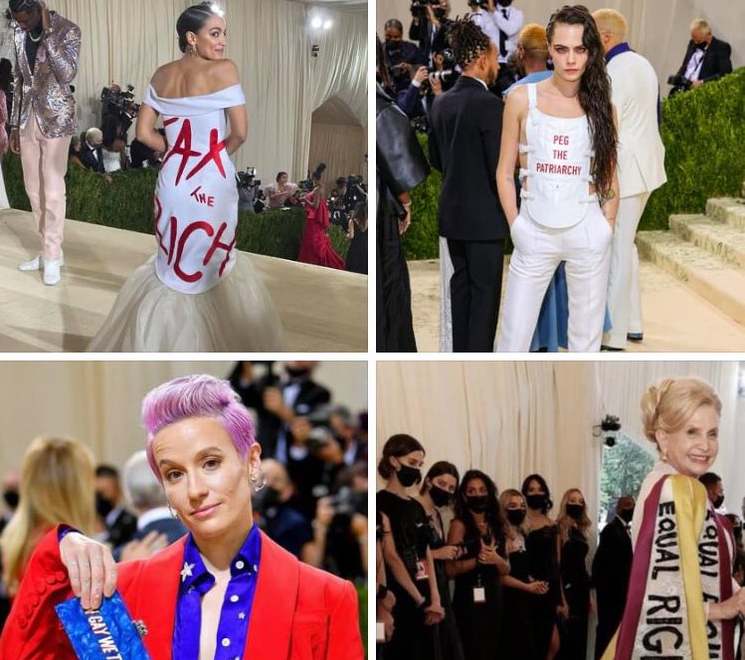Dress to Oppress

Author: Dom Rottman
23 September 2021
I’m going to come right out with it:
Alexandria Occasio-Cortez’s “Tax the Rich” dress is probably the least problematic thing about the entire event. That it has become the most controversial thing about the event (followed by Nicki Minaj’s cousin’s impotence and swollen testicles) is therefore most regrettable.
I wish to start, then, by demonstrating that her appearance at the Costume Institute Gala, popularly known as the Met Gala, is not only unhypocritical but reasonably within the bounds of today’s liberalism.
While there is ordinarily no conflict between the bleeding-heart liberal politicians of New York City and their attendance at one of its most bourgeois events—curious as it is that these events lead few to question liberals’ supposed commitment to the working class—the appearance of AOC in particular has caused a stir and accusations of hypocrisy. It seems then, that AOC, even if she has become less aggressive in her more egalitarian brand of liberalism, has not yet been admitted to the bourgeoisie in the American consciousness. Her left-liberal politics are still too left for the American liberal, and her humble origins as a bartender in the Bronx whose yearly wages likely matched the price of a seat at the Gala remain too much a part of her identity—she herself still identifying as a “working-class” woman while interviewed at the gala. Yet we can dispel accusations of simple hypocrisy with two simple facts: Her dress was borrowed from the artist and her ticket was paid for. Thus AOC is quite literally free to disrupt as much as she pleases.
Too bad she didn’t disrupt anything at all.
There is no more inanely liberal policy position than “Tax the Rich.” It makes no quantification. It makes no qualification. A majority of Americans support this position.The highest marginal tax rate in American history was over 90%. It is a political position at least as old as Hegel. And yet this is apparently news to the American political consciousness, it is apparently controversial to wear it on clothes, and apparently it was radical enough to drum up pearl-clutching and disquiet; some dare to even call it socialism!1 Yet perhaps I should not be so surprised. Even 150 years ago Karl Marx himself was amused at how the most modest and most liberal of economic reforms were castigated by politicians as such.2 Somehow the most controversial phenomenon last Monday was a liberal wearing liberal clothing with a liberal message to a liberal event attended by a bunch of liberals. And this, and only this, was deemed worthy of political scrutiny.
Never mind the other political statements borne on clothing. Supermodel Cara Delavigne wore a tasteful assault vest that read “peg the patriarchy,” Carolyn Maloney, unsure if she wanted to be a suffragette or the Queen of England, bore an “equal rights for women” banner, and Megan Rapinoe’s piece de resistance of her Hunger Games’ Capitol citizen ensemble was an “In gay we trust” clutch; all empty promises that will never come to pass borne by wealthy white celebrities granted the privilege of a full visage surrounded by masked servants—with a healthy POC concentration, I might add—dressed in monochrome black.
True hypocrisy! True Controversy! And for what? Perhaps the media has become so used to the inherent contradictions of liberal politics that political consistency has now become remarkable and itself controversial!
This is why people hate art. This is why today’s bourgeois culture rings hollow. Every recuperation is a deliberate inversion of aesthetics, it deliberately generates contradiction and passes that as the norm. “Equal rights” is no longer a demand, it has no power as a rallying call, because it has been recuperated by liberalism to the point of meaninglessness. Thus I would have to wear something more unsettling on my clothes—“Eat the Rich,” perhaps. If I had a free pass at the gala I would walk right up to any vapid mannequin under those overpriced tablecloth lanterns and call them a hypocrite. Art, fashion, and speech are restricted only to the bourgeoisie endowed with the privilege to lie. It shows that the only shred of honesty that got through at this event was a liberalism with all the ferocity and teeth of a baby goat.
It is much more than a dress. It’s more than simple liberal policies and empty platitudes. It’s one of many yearly reminders of the conditions and conditioning we live under, the morphology of our wealthy would-be saviors in all its gaudy, grotesque splendor.
Genuine disruption did occur that Monday, however. Down the block on that Monday, those who understand the power of tension, those who understand that business as usual needs to be disrupted, those who understand that words like “black lives matter” are more than fashion slogans assembled in a protest which was, naturally, suppressed with police violence, with several arrests made. We might imagine, then, that on other days, the steps of the Metropolitan Museum of Art are covered in a different kind of red.
And they tread upon it all the same.
-
This is of course categorically wrong, as socialism concerns worker control of the means of production. ↩︎
-
In The Eighteenth Brumaire of Louis Bonaparte, Marx analyzes how bourgeois interest was maintained after French Second Republic was proclaimed in 1848. “Every demand,” he writes, “of the simplest bourgeois financial reform, of the most ordinary liberalism, of the most formal republicanism, of the most insipid democracy, is simultaneously castigated as an ‘attempt on society’ and stigmatized as ‘socialism.’” Take comfort in the fact, then, that your latest television pundit or right-leaning representative is not any more careless and ignorant than your average 19th century French politician. ↩︎